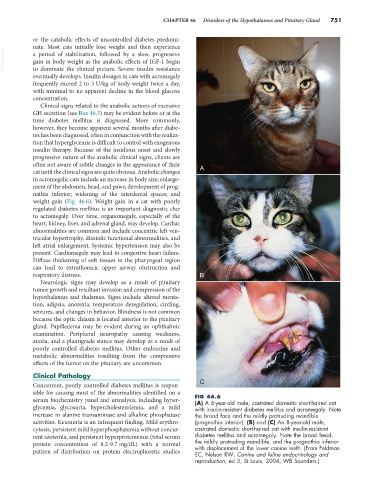Page 779 - Small Animal Internal Medicine, 6th Edition
P. 779
CHAPTER 46 Disorders of the Hypothalamus and Pituitary Gland 751
or the catabolic effects of uncontrolled diabetes predomi-
nate. Most cats initially lose weight and then experience
VetBooks.ir a period of stabilization, followed by a slow, progressive
gain in body weight as the anabolic effects of IGF-1 begin
to dominate the clinical picture. Severe insulin resistance
eventually develops. Insulin dosages in cats with acromegaly
frequently exceed 2 to 3 U/kg of body weight twice a day,
with minimal to no apparent decline in the blood glucose
concentration.
Clinical signs related to the anabolic actions of excessive
GH secretion (see Box 46.3) may be evident before or at the
time diabetes mellitus is diagnosed. More commonly,
however, they become apparent several months after diabe-
tes has been diagnosed, often in conjunction with the realiza-
tion that hyperglycemia is difficult to control with exogenous
insulin therapy. Because of the insidious onset and slowly
progressive nature of the anabolic clinical signs, clients are
often not aware of subtle changes in the appearance of their A
cat until the clinical signs are quite obvious. Anabolic changes
in acromegalic cats include an increase in body size; enlarge-
ment of the abdomen, head, and paws; development of prog-
nathia inferior; widening of the interdental spaces; and
weight gain (Fig. 46.6). Weight gain in a cat with poorly
regulated diabetes mellitus is an important diagnostic clue
to acromegaly. Over time, organomegaly, especially of the
heart, kidney, liver, and adrenal gland, may develop. Cardiac
abnormalities are common and include concentric left ven-
tricular hypertrophy, diastolic functional abnormalities, and
left atrial enlargement. Systemic hypertension may also be
present. Cardiomegaly may lead to congestive heart failure.
Diffuse thickening of soft tissues in the pharyngeal region
can lead to extrathoracic upper airway obstruction and
respiratory distress. B
Neurologic signs may develop as a result of pituitary
tumor growth and resultant invasion and compression of the
hypothalamus and thalamus. Signs include altered menta-
tion, adipsia, anorexia, temperature deregulation, circling,
seizures, and changes in behavior. Blindness is not common
because the optic chiasm is located anterior to the pituitary
gland. Papilledema may be evident during an ophthalmic
examination. Peripheral neuropathy causing weakness,
ataxia, and a plantigrade stance may develop as a result of
poorly controlled diabetes mellitus. Other endocrine and
metabolic abnormalities resulting from the compressive
effects of the tumor on the pituitary are uncommon.
Clinical Pathology
C
Concurrent, poorly controlled diabetes mellitus is respon-
sible for causing most of the abnormalities identified on a
serum biochemistry panel and urinalysis, including hyper- FIG 46.6
(A) A 6-year-old male, castrated domestic short-haired cat
glycemia, glycosuria, hypercholesterolemia, and a mild with insulin-resistant diabetes mellitus and acromegaly. Note
increase in alanine transaminase and alkaline phosphatase the broad face and the mildly protruding mandible
activities. Ketonuria is an infrequent finding. Mild erythro- (prognathia inferior). (B) and (C) An 8-year-old male,
cytosis, persistent mild hyperphosphatemia without concur- castrated domestic short-haired cat with insulin-resistant
rent azotemia, and persistent hyperproteinemia (total serum diabetes mellitus and acromegaly. Note the broad head,
protein concentration of 8.2-9.7 mg/dL) with a normal the mildly protruding mandible, and the prognathia inferior
with displacement of the lower canine teeth. (From Feldman
pattern of distribution on protein electrophoretic studies EC, Nelson RW: Canine and feline endocrinology and
reproduction, ed 3, St Louis, 2004, WB Saunders.)

